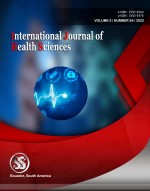Serum bilirubin as a diagnostic marker in acute appendicitis
A prospective study
Keywords:
Acute appendicitis, appendicular perforation, serum bilirubin, Hyperbilirubinemia, appendicectomy, MortalityAbstract
Background- Acute Appendicitis is the most common cause of acute abdomen. The initial diagnosis of acute appendicitis is based on clinical history and physical examination. Objectives- To determine the relationship between hyperbilirubinemia and acute appendicitis and to evaluate the usefulness of Serum Bilirubin as a diagnostic marker for acute appendicitis. Methods-It was Prospective study. Patients admitted with clinical diagnosis of acute appendicitis under the Department of Surgery in Vinayaka Mission’s KirupanandaVariyar Medical College and Hospital, Salem from January 2020 to October 2021. Convenient Sampling (Non-Probability) was used. The sample size was 100. Chi- square or Fischer exact test was used as test of significance. SPSS (Version 16.0) was used. Results-The mean Age among the subjects was 25.04 years ranging from 8 to 70 years. Among the subjects, 59 (59%) were Males and 41 (41%) were Females. Among the subjects, 81 (81%) had Acute Appendicitis and 19 (19%) had Appendicular Perforation.the patients with Direct bilirubin > 0.3 mg/dl, 15 (18.75%) had Appendicular Perforation and among the patients with Direct bilirubin < 0.3 mg/dl, 4 (20%) had Appendicular Perforation. There is no difference in Appendicular Perforation among patients with Direct bilirubin > 0.3 mg/dl and <0.3 mg/dl (18.75% vs 20%).
Downloads
References
Burcharth J, Pommergaard HC, Rosenberg J, Gögenur I. Hyperbilirubinemia as a predictor for appendiceal perforation: a systematic review. Scand J Surg SJS Off organ Finnish SurgSocScandSurg Soc. 2013;102(2):55–60.
Chambers AC, Bismohun SL, Davies H, White P, Patil A V. Predictive value of abnormally raised serum bilirubin in acute appendicitis: a cohort study. Int J Surg. 2015 Jan;13:207–10.
Emmanuel A, Murchan P, Wilson I, Balfe P. The value of hyperbilirubinaemia in the diagnosis of acute appendicitis. Ann R CollSurg Engl. 2011 Apr;93(3):213–7.
Estrada JJ, Petrosyan M, Barnhart J, Tao M, Sohn H, Towfigh S, et al. Hyperbilirubinemia in appendicitis: a new predictor of perforation. J GastrointestSurgOff J SocSurg Aliment Tract. 2007 Jun;11(6):714–8.
Giordano S, Pääkkönen M, Salminen P, Grönroos JM. Elevated serum bilirubin in assessing the likelihood of perforation in acute appendicitis: a diagnostic metaanalysis. Int J Surg. 2013;11(9):795–800.
Gürleyik G, Gürleyik E. Age-related clinical features in older patients with acute appendicitis. Eur J Emerg Med Off J EurSocEmerg Med. 2003 Sep;10(3):200–3.
Hansen JB, Smithers BM, Schache D, Wall DR, Miller BJ, MenZies BL. Laparoscopic versus open appendectomy: prospective randomized trial. World J Surg. 1996;20(1):17–21.
Heikkinen TJ, Haukipuro K, Hulkko A. Cost-effective appendectomy. SurgEndosc. 1998;12(10):1204–8.
Heinzelmann M, Simmen HP, Cummins AS, Largiader F. Is laparoscopic appendectomy the new’gold standard’? Arch Surg. 1995;130(7):782–5.
Lasek A, Pedziwiatr M, Kenig J, Waledziak M, Wysocki M, Mavrikis J, et al. The significant impact of age on the clinical outcomes of laparoscopic appendectomy: Results from the Polish Laparoscopic Appendectomy multicenter large cohort study. Medicine (Baltimore). 2018;97(50).
Lee SL, Stark R, Yaghoubian A, Shekherdimian S, Kaji A. Does age affect the outcomes and management of pediatric appendicitis? J Pediatr Surg. 2011 Dec;46(12):2342–5.
Mazzei MA, Guerrini S, Squitieri NC, Cagini L, Macarini L, Coppolino F, et al. The role of US examination in the management of acute abdomen. Crit Ultrasound J. 2013;5(1):1–9.
MoulaBux K, Parveen S, Iqbal M, Mehboob A. The effect of acute complicated appendicitis on liver function test. Pakistan J Med Sci. 2021;37(2):351–4.
Paajanen H, Mansikka A, Laato M, Ristamäki R, Pulkki K, Kostiainen S. Novel serum inflammatory markers in acute appendicitis. Scand J Clin Lab Invest. 2002;62(8):579–84
Sand M, Bechara FG, Holland-Letz T, Sand D, Mehnert G, Mann B. Diagnostic value of hyperbilirubinemia as a predictive factor for appendiceal perforation in acute appendicitis. Am J Surg. 2009 Aug;198(2):193–8.
Siewert B, Raptopoulos V, Mueller MF, Rosen MP, Steer M. Impact of CT on diagnosis and management of acute abdomen in patients initially treated without surgery. AJR Am J Roentgenol. 1997;168(1):173–8.
Suryasa, I. W., Rodríguez-Gámez, M., & Koldoris, T. (2022). Post-pandemic health and its sustainability: Educational situation. International Journal of Health Sciences, 6(1), i-v. https://doi.org/10.53730/ijhs.v6n1.5949
Türkyilmaz Z, Sönmez K, Karabulut R, Elbeğ S, Moralioğlu S, Demirtola A, et al. Sequential cytokine levels in the diagnosis of appendicitis. Scand J Clin Lab Invest. 2006;66(8):723–32.
Wido, A., Bajamal, A. H., Apriawan, T., Parenrengi, M. A., & Al Fauzi, A. (2022). Deep vein thrombosis prophylaxis use in traumatic brain injury patients in tropical climate. International Journal of Health & Medical Sciences, 5(1), 67-74. https://doi.org/10.21744/ijhms.v5n1.1840
Wray CJ, Kao LS, Millas SG, Tsao K, Ko TC. Acute appendicitis: controversies in diagnosis and management. CurrProbl Surg. 2013;50(2):54–86.
Published
How to Cite
Issue
Section
Copyright (c) 2022 International journal of health sciences

This work is licensed under a Creative Commons Attribution-NonCommercial-NoDerivatives 4.0 International License.
Articles published in the International Journal of Health Sciences (IJHS) are available under Creative Commons Attribution Non-Commercial No Derivatives Licence (CC BY-NC-ND 4.0). Authors retain copyright in their work and grant IJHS right of first publication under CC BY-NC-ND 4.0. Users have the right to read, download, copy, distribute, print, search, or link to the full texts of articles in this journal, and to use them for any other lawful purpose.
Articles published in IJHS can be copied, communicated and shared in their published form for non-commercial purposes provided full attribution is given to the author and the journal. Authors are able to enter into separate, additional contractual arrangements for the non-exclusive distribution of the journal's published version of the work (e.g., post it to an institutional repository or publish it in a book), with an acknowledgment of its initial publication in this journal.
This copyright notice applies to articles published in IJHS volumes 4 onwards. Please read about the copyright notices for previous volumes under Journal History.
















